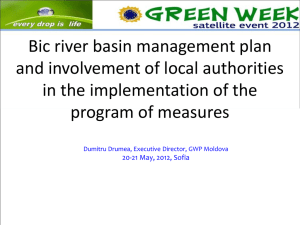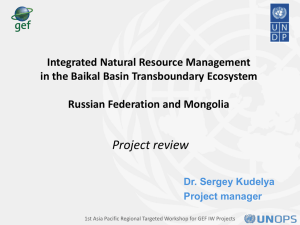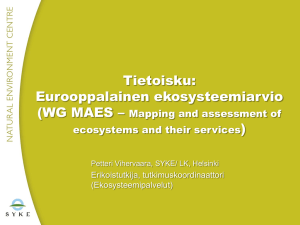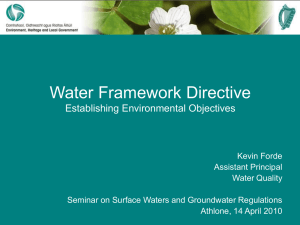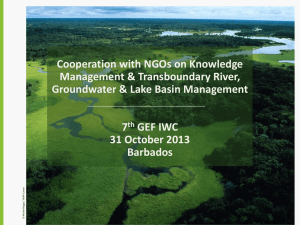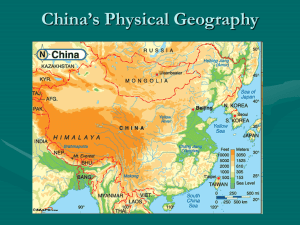Ecosystem Approach for studying biodiversity in the Selenga basin
advertisement
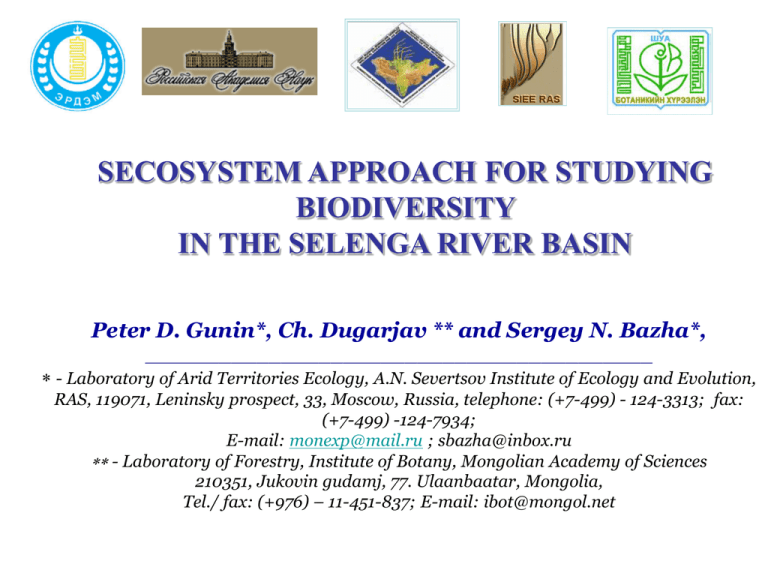
SECOSYSTEM APPROACH FOR STUDYING BIODIVERSITY IN THE SELENGA RIVER BASIN Peter D. Gunin*, Ch. Dugarjav ** and Sergey N. Bazha*, _________________________________________ - Laboratory of Arid Territories Ecology, A.N. Severtsov Institute of Ecology and Evolution, RAS, 119071, Leninsky prospect, 33, Moscow, Russia, telephone: (+7-499) - 124-3313; fax: (+7-499) -124-7934; E-mail: monexp@mail.ru ; sbazha@inbox.ru - Laboratory of Forestry, Institute of Botany, Mongolian Academy of Sciences 210351, Jukovin gudamj, 77. Ulaanbaatar, Mongolia, Tel./ fax: (+976) – 11-451-837; E-mail: ibot@mongol.net The main tasks • Biodiversity of the ecosystems, floristic and faunistic diversity; • Anthropogenic disturbance of the ecosystems; • SPA network analysis Baikal Basin Area Russian part Mongolian part Lake Baikal Basin’ border 1. The Lake Baikal basin area is more than 557 000 km2 (52% - in Mongolia and 48% in Russia). 2. Selenga River– is the transboundary water object in the core of the Asian continent and is the biggest tributary to the Lake Baikal ( around 30 km3 of water annually), that makes a half of total inflow to the Lake. The 46% of the annual run-off of the Selenga River is generated at the territory of Mongolia. 3. The Selenga River Basin area is 447 060 km2, of which 148060 km2 (33%) is within Russia and 299000 km2 (67%) within Mongolia, comprises over 80% of the Baikal Basin area. 4. The Selenga Delta of Lake Baikal is one of the world’s largest fresh water deltas occupying 680 km2. The main natural characteristics of the Selenga Basin Basin area of Selenga Baikal The Selenga River Basin lies in the ecotone zone of Southern Siberia and Central Asia. Significant area of the basin is in the semiarid zone, and includes forest, forest-steppe and steppe ecosystems. The length of the Selenga River is 1,024 km (of which 409 km are within Russia). The main tributaries to Selenga are Djida, Temnik, Chikoy, Khilok, Uda, Orkhon, Tuul, Muren, Egiin and Ider rivers. The Mongolian part of the Basin includes the Lake Khubsulgul basin. The main sources of water for the basin’ rivers are rains and thawing waters. Diversity of Ecotopes in the Selenga River Basin Tree groups of Ecotopes are divided and packaged by a dominant type of landscape-forming processes: • • • Denudational ecotopes of mountains, existing from rocky and semi-rocky materials, locally covered by friable deposits; Denudation-accumulative ecotopes of plateau, mainly lava, covered by thin layers of pebble-loamy deposits, and denudational, denudation-proluvial intermountain plains of friable deposits; Accumulative ecotopes of proluvium and alluvium, aeolian, alluvial, and alluvial-deltoid plains. Each of these groups combines a different types of concrete ecotopes (19 types in the legend) and mesoecosystems (49 types in the legend). Terrestrial Ecosystems Diversity in the Selenga River Basin - 206 combinations of meso-ecosystems; - More than 2400 contours; - Average area of contour is 3,2 km2. Source: Gunin P.D., Vostokova E.A., Bazha S.N., Prischepa A.V. (Ed.) 2006. Ecosystems of Mongolia: diversity, present state and conservation. Moscow. Rosselhozacademia. 313 p.(in Russian) Distribution of Ecosystems The spatial structure of meso-ecosystems at the Basin area depends from the latitude-zonal and high- altitude-zonal regularities, and has a number of regional features (geographic location of this area, its design and extents). Distribution of ecosystems type is a subject of zonal patterns in general, and clearly expressed in growing trends of diversity in direction from the north to the south (number of steppe ecosystems increase - forest and forest-steppe ecosystems decrease). The wide strip of mountain-taiga forests frames the central part of the Basin with a vast semi- ring. Thus, in the Basin along its southern border is absolutely woodless and is characterized with domination of dry-steppe ecosystems. The desert steppes and psammophilous ecosystems of bumpy and barchan-bumpy sands are completely presented here. The steppes are forwarding further to north with a wide stripe, fraying out at 52° northern latitude. The ecosystems of apical surfaces are located along the outer periphery of taiga “semi-ring” as the individual islands, rarely as more or less stretched stripes. This pattern is complicated with sub-latitude and sub-meridian location of the intermountain cavins, to which edges the steppe ecosystems are relevant. The main Terrestrial Ecosystem types in Russian and Mongolian part of the Basin ECOSYSTEM GROUPS Automorphic and semihydromorphic natural Hydromorphic natural Anthropogenic Russian Part Mongolian Part Area, % Area, % Golets and nival 0,9 3,6 Mountain-tundra-meadow 1,3 5,5 Sub-golets 5,5 3,5 Northern Taiga 11,8 9,2 Middle Taiga 22,0 12,9 Southern Taiga 16,6 13,5 Forest Steppe 5,6 30,7 Moderate Dry Steppe 1,7 0,7 Dry Steppe 5,7 7,6 High Mountain Forest 8,4 7,8 Forest-steppe and Steppe 15,2 1,2 Tillage and Fallow 3,1 2,5 Technogenic and Urbanized 2,0 1,4 Total 100 ECOSYSTEM TYPE 100 Floristic and Faunistic Diversity • • • • • • • • About 2,000 species of vascular plants representing over 600 genera and 100 families grow in the Russian part of the Lake Baikal Basin. Here 180 species are endemic. The region is the habitat of 380 species of bryophytes and about 450 species of lichens. The fauna is also rather rich and diverse, with over 90 species of mammals, about 400 species of birds, over 20 species of reptiles and amphibians, and 35 species of fish. The flora of Mongolian part of the Selenga River Basin presented by 2,010 species of vascular plants, which belong to 476 genera and 95 families. The greatest floristic diversity characterizes the ecosystems of the Khangai (1,427 species) and Khentei-Chikoi (1,229 species) uplands. Those mountains are inhabited by 37 endemic species of flora. The Baikal Basin can be referred to the floristically rich regions in North Eurasia. The fauna of the Lake Baikal Basin is also extremely diverse although it has not been studied thoroughly so far. The Baikal region is inhabited by about 3,500 species of coleopterous beetles. The numbers of vertebrate species in terrestrial ecosystems reaches 540, of which 6 are amphibians, 6 are reptiles, 458 are birds and 70 are mammals. Protected species of Flora and Fauna in Buryatian and Mongolian part of the Basin (by:Red Books of Mongolia, 1988; Buryatia, 1997) Type Buryatia Northern Mongolia Fauna (total) Mammals Birds Reptiles Amphibias Fish Insects Mollusca 129 51 25 70 4 3 5 22 0 10 21 0 2 3 14 1 Flora (total) 121 75 Vasculares Bryophyta Algae Lichens 115 0 0 6 0 55 2 4 9 5 Mushrooms The number of protected flora and fauna species in Northern Mongolia and Buryatia within the boundaries of the Lake Baikal Basin totals 129 animal and 121 plant species, while the Red Book of Mongolia includes only 51 animal and 75 plant species. Some of the species listed in the Red Book of Buryatia are absent from the Red Books of Mongolia, although they are found in those regions. Anthropogenic Disturbance of the Selenga River Basin Diagnosis of Dangerous Degradation Processes in terrestrial ecosystems Using the detailed analysis of ecosystems condition and study of dynamics of its components was established a main groups of the most hazardous processes defining factors of impact and ecological risks affecting biodiversity and environmental safety: 1- Expansion of alkaloid and poisonous plants 2-Bush encroaching in pasture ecosystems 3-Deforestation of forest –steppe ecosystems 4-Desertification soil-plant cover 5-Impoverishment of hydromorphic ecosystems 6 – Expansion of destructive harmful pests into larch and birch forest 1. Expansion of alkaloid plants into NaturalAnthropogenic Ecosystems Invasion of Hemp species (Cannabis sativa, C. ruderalis) , Ephedra sinica, Peganum harmala e.t.c) 2. Bush encroaching in steppe pasture ecosystems Replacement of typical dominant grass species by shrubs and dwarf subshrubs Caragana microphylla, Juniperus pseudosabina, Artemisia frigida, Amygdalus pedunculata 3. Deforestation of foreststeppe ecosystems Formation of new bush communities (Betula fusca, Spiraea aquilegifolia, Armeniaca sibirica, Amygdalus pedunculata, Dasiphora fruticosa, etc.) instead of coniferous forest 4. Impoverishment of hydromorphic ecosystems Outgrowth of low- and non eatable species : Iris Bungei, I. Lactea, I. Dichotoma, Artemisia laciniata, A. adamsii, A. commutata in degraded ecosystems 5. Desertification of soil-plant cover: Depletion of grass sod and humus horizons and formation dune relief with typical desert plants: Agriophyllum pungens, Corispermum mongolicum, Psammochloa villosa etc. 6 Expansion of harmful destructive pests into larch and birch forest Siberian moth (Dendrolimus sibiricus) Gipsy moth (Limantria dispar) SPA network analysis Due to intensive anthropogenic transformation in terrestrial ecosystems of the Selenga River Basin (up to 65% of the area), the role of present and planned SPAs is a key issue for ecosystems protection and rehabilitation. Specially Protected Areas, Mongolian Part • • • The total area of Mongolian SPNS is 205,300 sq. km (13% of the country’s territory), and those situated in the Baikal Basin have an area of 24,800 sq. km, or 8.5% of the Basin territory. In Mongolia, SPNS are located in their highest concentration in the Western, Southern and Eastern parts of the Basin. However, there are practically no SPNS in the central part of the Basin. Area of presence under protection by the type of ecosystems (Mongolian part) Area, sq. km Good: 1,2,3,4 – High-mountain nival and loaches; 7 – Larch and cedar-larch sparse growth of trees on the high-mountain and middle mountain ecotopes; 12,13 – cedar and larch forest with bushes on the frosen podsolic soils. Poor or nonpresented: 5,6 – sub-golets types with larch, cedar sparce grows elfin wood; 14 – middle taiga birch and pine forest on podzolic soils; 18 – south-taiga pine-larch forest with birch and bushes on turfy-podzolic soils; 21 – steppe meadows in mountain; 38 – bushy birch forest with larch in comb. with bunchgrass meadows; 41 – high grassy marshes with reed and willow on the meadow-swampy soils. Ecosystem index Specially Protected Areas, Russian Part • • • Almost the entire part of the Basin located in Irkutsk Province enjoys protection and constitutes an almost uninterrupted belt along the Western lake shore. In the territory of Buryatia, the largest protected sites are also situated close to Lake Baikal (outside from The Selenga basin), while others are mostly small separated temporary reserves. In the Republic of Buryatia, the area of protected sites is 3.6 million hectares, which constitutes 10% of the Baikal Basin territory, but less than 3,5% of the Selenga River Basin. Area of presence under protection by the type of ecosystems (Russian part) Sq. km Good: 13 – High-mountain Forests; 19 – forest-steppe and forest on plains of river deltas; 44, 46 – swampy meadows with willow and reed. Poor or nonpresented: 1, 2 - high mountain nival; 11- birch, alder and cedar forest on frosen podsolic soils; 21- steppe meadows with bushes on the meadow-chernozem soils; 31, 32 – steppe with caragana and bunchgrasses on the sandy lite chestnut soils; 39 – motley grass meadows with cereals and willow on the flood-meadow soils. Index of ecosystem Location of existing and planned SPAs in the •In terms of SPAs Selenga River Basin optimization in the Selenga Transboundary Cluster Biosphere Reserve ? ? Baikal basin the most obvious and urgent task is establishment of a transboundary cluster biosphere reserve in its mid part, which basic function should not be only conservation of inundated-valley, mountain-forest and mountainsteppe ecosystems, but the establishment of ecological and geochemical monitoring in the central part of the Baikal basin as well. Location of planned SPA in the Selenga River Basin • Ecotone character of Baikal basin biota, prevalence of mountainforest (50,5% in the Russian part and 35,5% – in Mongolian) and mountain-steppe (11,3% and 31,9% respectively) ecosystems at its territory, as well as their high spatial mosaics imply the cluster organization of infrastructure of a TBR in the central part of the Selenga basin. • Establishment of TBR should be grounded on the following three basic principles which determine the importance of each parts in conservation of ecosystem and biological diversity: - existence of aboriginal and pseudo-aboriginal communities – ecosystems of virgin and weakly disturbed dark and light coniferous forests; - existence of unique mountain forest-steppe ecosystems in Sothern Siberia and Northern Mongolia; - existence of endemics, relict and rare species in plant associations. In conclusion • Implementation of planned activities on the establishment of a new cluster biosphere reserve in a mid part of the Selenga River Basin would allow for not only improve the conservation of ecosystem and biological diversity of unique Baikal region, but detect beforehand and prevent adverse anthropogenic alterations in both the terrestrial basin ecosystems and the Baikal aqua-systems. * * * Спасибо за внимание! Thank You for attention
